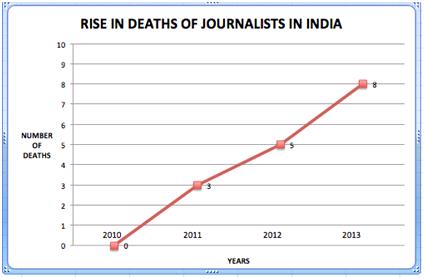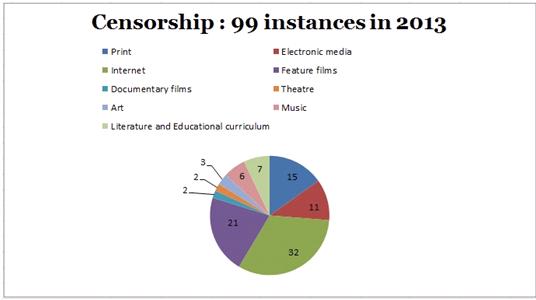Spike in curbs on free speech in 2013

Free Speech in India 2013: A report from The Free Speech Hub of the Hoot
Highlights
· Deaths : eight deaths in 2013
The number of journalists killed has risen in the last three years. From three in 2011 and five in 2012, there have been eight deaths of journalists in 2013, of whom six are from Uttar Pradesh and two from Chhattisgarh. No arrests have been made in connection with any of their deaths. Maoist groups are suspected to have killed both journalists from Chhattisgarh. With the exception of one, the rest were stringers.
Censorship : 99 instances in 2013
The number of instances of censorship this year rose from 74 in 2012 to 99 in 2013. As in the previous year, the single biggest category of instances was Internet related. (32). In 2012 the figure was 41. The second largest category was film related as at least 20 commercial films saw problems over content, titles, songs and dialogues.
Attacks : 20 instances in 2013
The brutal acid attack on a journalist in Parbhani, Maharashtra, and the attempt to burn alive another journalist in Kolkata, West Bengal are part of the 20 instances of attacks on journalists and other citizens in 2013. Of these, four attacks came from political parties while in seven instances, the media was targeted while covering protests.
Surveillance
The increasing surveillanceof citizens, by both state and private bodies, aided by technology as well as official policy, is a matter of grave concern. These forebodings were flagged in the very first Free Speech Report of 2010. Now, ‘official’ mechanisms are being put in place to conduct surveillance with little or no scrutiny – be it the Central Monitoring System, the National Intelligence Grid (NATGRID), the threat to privacy inherent in the Aadhar card scheme, the interception of electronic communication by officially appointed agencies or the social media labs and cyber cells of police forces.
|
Categories
|
2013
|
2012
|
|
Deaths of journalists
|
08
|
05
|
|
Attacks
Threats
Harassment
Arrests/detentions
Total
|
20
04
02
25
|
39
|
|
Censorship :
Print
Electronic media
Internet
Feature films
Documentary films
Theatre
Art
Music
Literature and Educational curriculum
Total
|
15
|
08
|
|
11
|
04
|
|
|
32
|
41
|
|
|
21
|
14
|
|
|
02
|
||
|
02
|
|
|
|
03
|
||
|
06
07
99
|
07
74
|
|
|
Privacy & Surveillance
|
13
|
05
|
|
Defamation
|
07
|
02
|
|
Hate speech
|
10
|
02
|
|
Policy, judiciary, regulation
|
07
|
03
|
|
Sedition
Contempt
Legislative Privileges
|
02
02
01
|
|
The deaths of journalists on duty – eight in 2013, from the five last year and the three the year before– is a chilling reminder of the slow erosion of free speech in the world’s largest democracy. Added to this is the increasing surveillanceof citizens, by both state and private bodies, aided by technology that citizens are scarcely aware of.
The list of deaths of journalists could have been worse – with the brutal acid attack on a journalist in Parbhani, Maharashtra, and the attempt to burn alive another journalist in Kolkata, West Bengal. These are part of the 20 instances of attacks on journalists and other citizens tracked by the Hoot’s Free Speech Hub for 2013.
Even as journalists face increasing attack, censorship is on the rise – with 99 instances in all. The rising graph of deaths, attacks and threats to journalists as well as a range of citizens from writers, artists, theatre performers, political activists or students who speak up on social media is an indication of intolerance to alternative ideas and opinions but it also exemplifies the impunity which the attackers enjoy, often with the complicity of the very authorities entrusted with the task of upholding law and order.
Through the year, surveillance – flagged by the first report of Free Speech Hub in 2010 – was the major issue for free speech throughout the world, triggered by the revelations of the US government’s NSA. India was fifth on the list of countries under surveillance but the Indian government’s tepid response was only made worse by the defence of Union External Affairs minister Salman Khurshid that the US government’s programmewas ‘not actually snooping’ but computer analysis of call patterns and emails!
The minister’s remarks are at variance with the government, which initially termed the privacy violations as ‘unacceptable’. Documents leaked by whistleblower Edward Snowden, a former technical assistant for the CIA, revealed that India was the fifth most tracked country by the US intelligence which used a secret data-mining programme to monitor worldwide internet data. US intelligence services spied on 38 embassies and diplomatic missions of its allies that included India.
There was little or no transparency in the quiet rolling out of ‘official’ mechanisms being put in place to conduct surveillance – be it the Central Monitoring System, the NATGRID, the threat to privacy inherent in the Aadhar card scheme, the interception of electronic communication by officially appointed agencies or the social media labs and cyber cells of police forces.
Deaths and attacks
While the total death of journalists is eight this year, two are from Chhattisgarh –Nemichand Jain and Sai Reddy, killed by suspected Maoists. All the rest are from Uttar Pradesh – Rakesh Sharma, ShashankShukla, LekhramBharti and Zakiullah while Rajesh Verma and Israr died during the Muzaffarnagar riots that engulfed the state in September.
Maoists had targeted both Jain and Reddy and a Maoist sub-committee owned up responsibility for Jain’s death. Reddy, a regular contributor to a respected local newspaper, Deshbandhu, had earned the ire of local police, the SalvaJudum as well as the Maoists for his writings exposing corruption. Police suspect Maoist involvement in the killing of Reddy, though he was arrested under the Chhattisgarh Special Public Security Act in 2008 for allegedly being close to the Maoists! There is no official statement from the Maoists owning responsibility for the attack.
There were19 attacks on journalists this year while there were four other instances of threats to the media, to speakers at public meetings or newspaper offices and two instances of harassment of women for online content.
The deaths illustrate the very precarious working conditions of the journalists. With the exceptionof Rakesh Sharma who worked with newspaper Aaj, all the rest were stringers and had little or no formal organizational support. The killings, as well as the increasing attacks on journalists, have had a chilling effect on news-gathering, as journalists are wary of venturing into dangerous territory and stick to safe topics instead.
In two instances, supporters of self-styled godmanAsaramBapu attacked journalists who were covering his arrest on sexual molestation charges. In three separate instances, internecine clashes broke out between political party supporters of the BJP, Congress and the Trinamool Congress but they quickly turned their ire at mediapersons who covered the clashes.
The most vicious of these attacks on journalists was by the Trinamool Congress, who tried to burn a journalist alive, leaving another unconscious.
“They confined me in the room and started beating me. Then one of them poured petrol on me. They were about to burn me alive when some locals stormed inside and after a scuffle, managed to protect me,” said BarunSengupta, journalist with television channel 24 Ghanta.
While impunity ruled a majority of the instances of deaths and attacks, swift police action was effective in nabbing the prime accused in this case. Police managed to trace the cell phone of ShibuYadav, who attempted to escape to neighbouring Bihar and arrested him, along with eight accused.
Censorship
If the increasingly vicious attacks aren’t enough of a wake up call, take a look at the number of instances of censorship –99 in all, ranging from curbs on print, broadcast and Internet media; protests and cases against film titles, songs and dialogues and bans on film screenings; disruptions and vandalism in documentary film screenings, theatre performances and art shows, cases lodged against authors and take down of content in school text-books.
Curbs on print and broadcast media ranged from police cases against editors, gags on the media in Kashmir in the wake of the hanging of Afzal Guru, ban on media coverage of the Delhi gangrape trial or suspension of television programmes like ‘Comedy Central’ or ‘Bigg Boss’ for violation of content codes. But other cases of censorship had far-reaching implications for media freedom, notably two decisions of the National Investigation Agency (NIA) to demand that a Manipur newspaper editor disclose the source of a photograph on an insurgency group and another, to gag media coverage of the Bhatkal case.
Censorship of online content, 32 instances in all through the year, included arrests of citizens for posting comments on various social networking sites. Dalit writer KanwalBharti was arrested for his Facebook comments on IAS officer Durga Shakti Nagpalwhile Bangladeshi write-in-exile TaslimaNasreen faced in FIR for her tweet on the support sought by AamAadmi Party (AAP) leader ArvindKejriwal from a cleric who issued a fatwa against her!
Students continued to fall afoul of their educational institutions and, in at least six instances, students were either suspended or expelled from their institutions for their Facebook posts. And here’s a good illustration of institutional discomfort towards GenNext: the Delhi government guidelines banned teacher-student bonding over social media as part of its internet safety protocol!
But other areas of censorship only indicate that was a free-for-all all year. In case after case, vigilante groups managed to get their way to curb any free expression, reducing all the clear laws and directives that exist, to mere paper. Aided, at times, by pliant law enforcing authorities who looked the other way, they managed to hold the interests of others to ransom.
Consider a few instances, random pickings from the Hoot’s 2013 Free Speech Tracker:
-
The police in Chiplun, Maharshtra, decide to drop a speaker – the respected PushpaBhave – from a programme the police themselves organized to discuss violence against women – only because the local Shiv Sena objected to her presence as she was a well-known critic of their deceased leader Bal Thackeray!
-
The Tamil Nadu government decided to hold the release of Vishwaroopam, though it had been awarded acertification because they apprehended law and order issues.
-
A special screening is arranged for Muslim clerics to ‘certify’ a film on an anti-terror theme to ensure its safe passage before the film certification board.
-
All these films have one plot in common and no, its not their box-office takings: Vishwaroopam, Dam 999, Kadal, KangalMalsat, Jolly LLb., Race 2,Annakodi,Go Goa Gone, TaurMittran Di, Shootout at Wadala, SaddaHaq, Gouravam, Madras Café, BhaagMilkhaBhaag,Thalaivaa, (Goliyon k….)Ramleela, YaRab and Miss Lovely.
-
Right-wing Hindu fundamentalist groups targeted documentary film screenings, theatre shows and vandalized art exhibitions while police remained spectators
-
Political insurgency groups vented their ire on Hindi film songs, banning them from being played at weddings and festivals
-
Unsavoury references to various communities and historical characters were excised from text-books and authors like Yogesh Master (Dhundi) and KhetrabasiNaik (Dadan) faced community wrath with the former being arrested for his reference to the Hindu god Ganesh. The latter, who was given a SahityaAkademiYuvaPuraskar, was asked to apologise for his portrayal of migrant workers.
But this year also saw resistance to censorship. The Ajoka theatre group from Pakistan, who faced the cancellation of their show ‘KaunHaiYehGustakh’ by the National School of Drama, found another willing theatre venue and the show went on.
Hate Speech
The year began with confrontations over hate speech, speech with the protests and arrests of Hyderabad MLA AkbaruddinOwaisi and the intense debates over the comments of scholar AshishNandy about corruption and the scheduled castes. Cases were lodged against a number of politicians, including Maharashtra Home Minister R RPatil and the then Karnataka deputy Chief Minister K S Eshwarappa.
While former Union minister AnbumaniRamadoss was arrested, Maharashtra NavnirmanSena leader Raj Thackeray continued to evade arrest. But, while BJP leader Varun Gandhi was acquitted in both cases of hate speech lodged against him, two Shiv Senacorporators were convicted, albeit for two months, for hate speeches during the Mumbai riots 21 years ago!
Surveillance and Privacy
Apart from the stealthy rolling out of the (CMS) at an estimated cost of Rs 400 crores, the year saw almost all the big internet companies coming out with their own transparency reports, following in the lines of the Google Transparency Report. All the reports recorded increases in take down requests from the Indian government. Google reported a 20 per cent hike in requests from India to take down content, Microsoft admitted revealing subscriber data, complying with 370 out of 400 requests. Facebook’s Global Government Requests Report revealed that India made the second largest number of requests –3,245 in all and the company complied in 50 percent of the requests but requests to Twitter were less than ten percent, the company said.The Indian government finally prevailed upon Blackberry to deploy an interception solution.
Privacy issues came up too and the more stringent amendments to rape law were tested in January with a case against Zee News channel for telecasting an interview with the friend of the Delhi gangrape victim. While hearings continued on the privacy case filed by industrialist Ratan Tata, a special team was appointed by the Supreme Court to analyse the Radia tapes.
But there are apprehensions that Mumbai police may compromise privacy with the setting up of a social media lab to monitor content on social networking sites. At an inauguration at the hands of a Bollywood actor, police proclaimed that the lab would tune into the content and chatter by young users!
Policy
Apart from laying down a surveillance mechanism, the Union government took some policy initiatives, including the appointment of a committee headed by Justice MukulMudgal, which suggested changes in the Cinematograph Act, 1952.
But other developments bode ill for free speech, including government controls, in the form of regulations of advertisements in print and broadcast media, the visa denial to controversial film-maker CallumMacrae, little or no relief in court cases challenging Sec 66 (a) of the Information Technology Act, 2000 or the attempts by government officers to push for inclusion of Internet companies to follow Indian laws.
Read the full report here:

